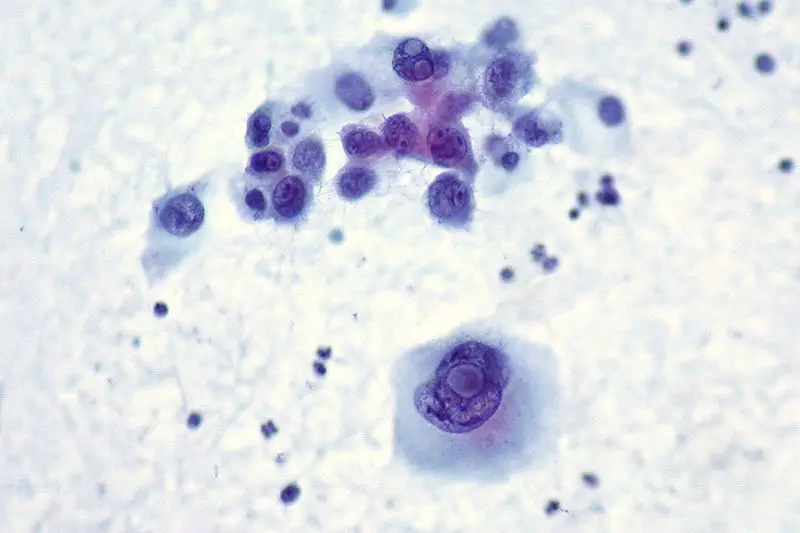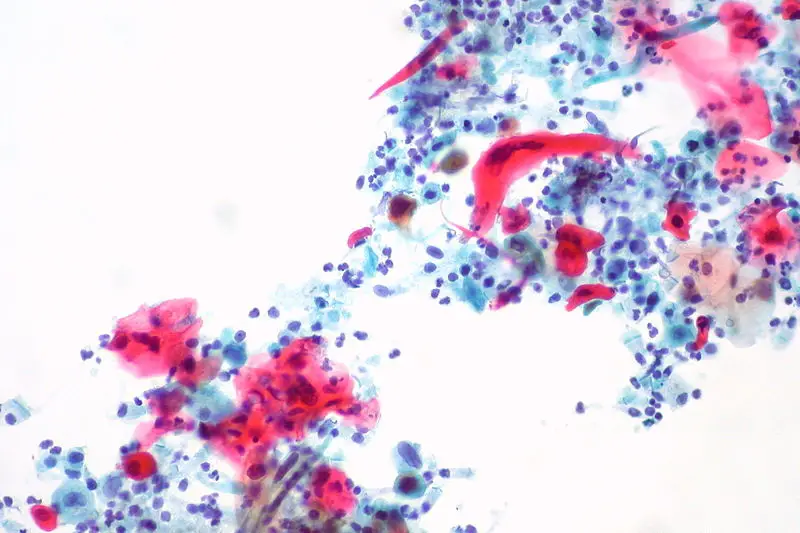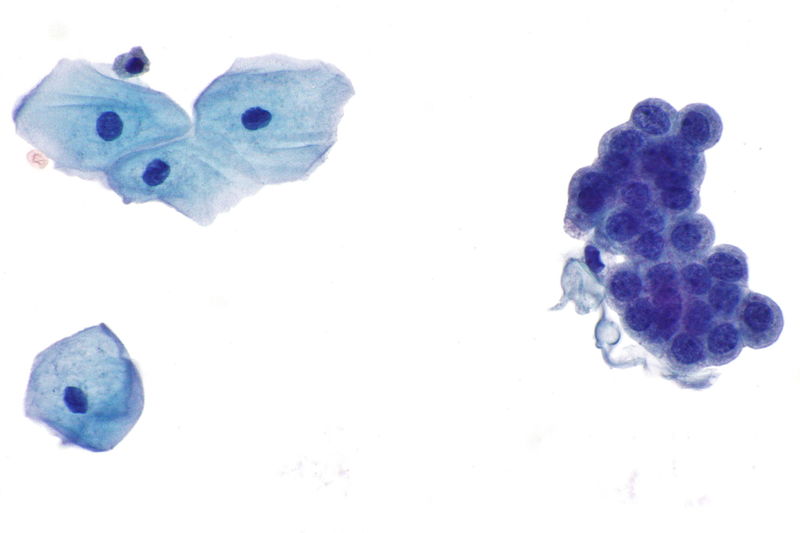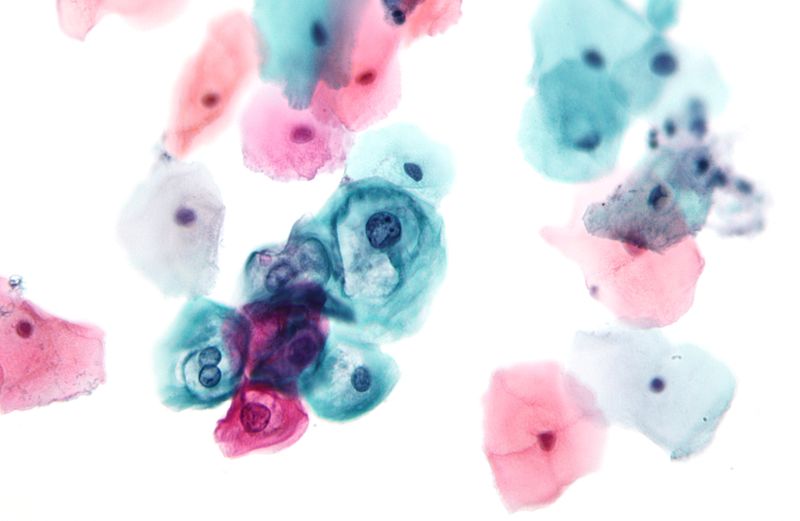Table of Contents
Papanicolaou Staining (Pap stain)
- Papanicolaou stain can also be referred to as the pap stain, and the process that causes the stain is referred to as a pap smear.
- It is a polychromatic stain that makes use of multiple dyes to stain different components of the cells.
- It is a cytopathological as well as histological staining technique that is used to differentiate cells within the smears.
- The most commonly used screening method used to detect cervical cancer.
- Many specimens can be used to make the pap smear, based on the screening infection, such as urine, sputum, cerebrospinal liquid, abdomen tissue, tumor biopsy, synovial fluid, and fine-needle aspirates, and pleural fluids.
- The technique was invented by George Papanicolaou in 1942.
Objectives of Papanicolaou Staining (Pap stain)
- To identify the nuclear component of the cell to assist in the detection of abnormalities in the nuclear structure of cancerous cells.
- For cytoplasm staining, and make it transparent to allow for visual inspection
- To differentiate and distinguish specific cell types like basophils and acidophils.
Principle of Papanicolaou Staining (Pap stain)
The stain employs both acidic and basic dyes, so that the basic dye stain acidic elements of the cell, while the acidic dyes stain the fundamental components of cells. It is based on Ionic charges of the elements of the cell based on the concept of attraction and repulsion between the ions as well as the dyes. Five dyes are employed in three solutions to serve as the principal reagents for staining.
- Hematoxylin: It is an organic dye which stains the nuclear cell blue. It binds to DNA’s sulfate group because it has a strong affinity to nuclear chromatins. The most commonly dyes for hematoxylin are Harris Hematoxylin. Gills Hematoxylin H, which is the most common cytologically however Gills Hematoxylin and Hematoxylin S.
- Orange Green 6: It is an acidic counterstain which is stains on the cells’ cytoplasms of mature keratinized. The constituents of the target dye are orange with varying intensities of dye.
- Eosin Azure: It’s the second counterstain. It is a mixture of eosin Y light green SF as well as Bismarck brown. Eosin Y stain the cells’ cytoplasms of mature squamous cells, nucleoli, red blood cells and the cilia pink. The most popular eosin dyes for this purpose are EA 31 and EA 50 and EA 65. Light green SF stain the cytoplasm of active cells, such as parabasal squamous cells, columnar cells, intermediate squamous cells, Blue. Bismarck brown Y is not stained and, in some cases, it is left out.
Composition of the Reagents of Papanicolaou Staining (Pap stain)
Harris’ hematoxylin
- Hematoxylin = 2.5g
- Ethanol = 25ml
- Potassium alum = 50g
- Distilled water (50°C) = 500ml
- Mercuric oxide = 1-3g
- Glacial acetic acid = 20ml
Orange G 6
- Orange G (10% aqueous) = 25ml
- Alcohol = 475ml
- Phosphotungstic acid = 0-8g
EA 50
- 0.04 M light green SF = 5ml
- 0.3M eosin Y = 10ml
- Phosphotungstic acid = 1g
- Alcohol = 365ml
- Methanol = 125ml
- Glacial acetic acid = 10ml
Other Reagents comprise 95% ethanol, 100 percent ethanol, tap water, Scott’s tap water, xylene
Procedure for Papanicolaou Staining (Pap stain)
- Fixe the smear by using 95 percent Ethanol 15 minutes
- Rinse under tap water
- Incorporate the Harris Hematoxylin dye for about 1-3 minutes.
- Rinse using the tap or Scott’s tap water
- Dip the prepared into 95% Ethanol 10 dips
- Orange G-6 stain to be added to 1.5 minutes.
- Dip into 95 percent Ethanol 10 dips
- Include Eosin dye, EA-50 or modified EA-50, EA-65 stain, for 2.5 minutes.
- Dip into 95% ethanol for 10-dips. 2 variations
- Make sure to add 100% Ethanol for 1 minute.
- Clear in two changes of xylene for 2 minutes each
- Mount using permanent mounting medium
Results and Interpretation of Papanicolaou Staining (Pap stain)






- Nuclei: Blue
- Acidophilic cells: Red
- Basophilic cells: Blue Green
- Erythrocytes: Orange-red to dark pink
- Keratin: Orange-red
- Superficial cells: Pink
- Intermediate and Parabasal Cells: Blue-Green
- Eosinophil: Orange Red
- Metaplastic cells: May contain both blue/green and pink
- Candida: Red
- Trichomonas: Grey-green
Applications of Papanicolaou Staining (Pap stain)
- It is used as part of the Pap test (or Pap test).
- Checking the cervical area for cancer.
- Examining the myeloma cancerous cells in the liver.
- Examining thyroid cancer for the first time.
- Checking the cells for cancer.
- Examining and identifying benign cancers.
- Identification of species of Candida.
- Identification of Chlamydia Trachomatis.
Limitations of Papanicolaou Staining (Pap stain)
- It’s merely screening tests that need to be followed by additional special tests for diagnosing.
- It is sensitive but has only a small amount of accuracy.
FAQ
What is Papanicolaou staining (Pap stain)?
Papanicolaou staining (Pap stain) is a histological staining technique used to evaluate cellular material from cervical or vaginal smears for the diagnosis of cancer or other abnormal conditions.
What type of sample can be stained using Papanicolaou staining?
Papanicolaou staining is used on cervical or vaginal smears to detect abnormal cells.
How does Papanicolaou staining work?
Papanicolaou staining works by using dyes that bind to different components of cells, such as nuclei, cytoplasm, and mucus, to create a color-coded image of the sample.
Is Papanicolaou staining a qualitative or quantitative technique?
Papanicolaou staining is primarily a qualitative technique, as it is used to identify the morphological features of cells and diagnose abnormal conditions.
What is the sensitivity of Papanicolaou staining?
The sensitivity of Papanicolaou staining can vary, but it is generally considered to be high for detecting abnormal cells in cervical or vaginal smears.
What are the advantages of Papanicolaou staining?
The advantages of Papanicolaou staining include ease of use, low cost, high sensitivity for detecting abnormal cells, and widespread availability.
What are the disadvantages of Papanicolaou staining?
The disadvantages of Papanicolaou staining include potential for false negatives or false positives, subjectivity in interpretation, and the need for trained professionals to interpret the results.
Is Papanicolaou staining the only test used to detect abnormal cells in cervical or vaginal smears?
No, Papanicolaou staining is often used in conjunction with other diagnostic tests, such as HPV testing, to detect abnormal cells in cervical or vaginal smears.
What is the cost of Papanicolaou staining?
The cost of Papanicolaou staining can vary depending on the location and type of test, but it is generally considered to be low cost compared to other diagnostic tests.
How long does it take to get the results of a Papanicolaou stain?
The time it takes to get the results of a Papanicolaou stain can vary, but it is usually within a few days to a week after the sample is collected.
References
- https://universe84a.com/pap-stain-introduction/
- https://microbenotes.com/papanicolaou-staining/
- http://www.bmrat.org/index.php/BMRAT/article/view/80
- http://www.ihcworld.com/_protocols/special_stains/papanicolaou_stain.htm
- https://www.ncbi.nlm.nih.gov/pmc/articles/PMC9345133/
- https://www.karger.com/Article/Fulltext/457827
- https://www.itwreagents.com/download_file/ce_ivd_instructions/CEIVD14/en/CEIVD14_en.pdf
- https://www.sciencedirect.com/topics/medicine-and-dentistry/papanicolaou-stain
- https://link.springer.com/article/10.7603/s40730-016-0006-8
